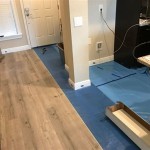Underlay for laminate flooring is an essential part of any flooring installation. It is designed to provide a cushioning layer between the laminate flooring and the subfloor. This cushioning layer helps to reduce noise from the laminate flooring, provides insulation against moisture, and helps to even out any irregularities in the subfloor. Underlay for laminate flooring can also help to increase the life of the laminate flooring, by providing a more even surface for the laminate planks to lay on.
Types of Underlay for Laminate Flooring
There are several types of underlay for laminate flooring, including foam, cork, rubber, and felt. Each type of underlay has its own benefits and drawbacks, so it’s important to choose the right one for your needs. Foam underlay is the most common type of underlay for laminate flooring, as it is inexpensive and provides excellent sound and thermal insulation. Cork underlay is another popular option, as it is highly durable and provides good insulation and sound absorption. Rubber and felt underlay are also available, but they are not as commonly used as foam and cork.
Benefits of Underlay for Laminate Flooring
Underlay for laminate flooring has many benefits, including reducing noise, providing insulation, and helping to even out any irregularities in the subfloor. By reducing noise, underlay can help to create a more peaceful and comfortable environment in your home. Insulation helps to keep the floor warm in the winter and cool in the summer, helping to reduce your energy costs. The cushioning layer also helps to protect the laminate planks from any unevenness in the subfloor, prolonging the life of your flooring.
Preparing the Subfloor for Underlay Installation
Before you install the underlay, it’s important to prepare the subfloor. Any loose debris, such as nails and screws, should be removed and the subfloor should be swept and vacuumed to remove any dust. If the subfloor is uneven or has any large gaps, these should be filled with a suitable filler. Once the subfloor is prepared, the underlay can be cut to size and installed.
Installing the Underlay for Laminate Flooring
Installing underlay for laminate flooring is relatively straightforward. First, the underlay should be rolled out and cut to fit the shape of the room, leaving a few inches of extra material around the edges. The underlay should then be secured to the subfloor using a felt-paper adhesive and plastic sheeting, to ensure that it stays in place. Once the underlay has been installed, the laminate flooring planks can then be laid on top.
Conclusion
Underlay for laminate flooring is an essential part of any laminate flooring installation. It helps to reduce noise, provide insulation, and even out any irregularities in the subfloor, prolonging the life of your flooring. Installing the underlay is relatively straightforward, but it’s important to make sure that the subfloor is properly prepared before you begin. Once the underlay is in place, the laminate flooring planks can then be installed on top.


/laying-laminate-flooring-5c36643946e0fb0001102b5b.jpg)







/Laminate-floor-install-GettyImages-154961561-588816495f9b58bdb3da1a02.jpg)

/laying-laminate-flooring-5c36643946e0fb0001102b5b.jpg)


Related Posts








